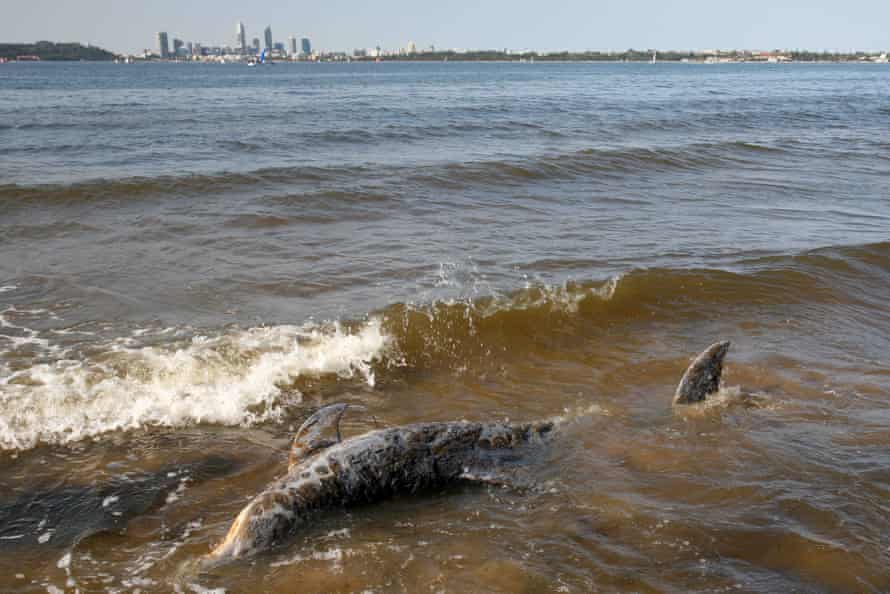Dolphins are increasingly dying slow, painful deaths from skin lesions likened to severe burns as a result of exposure to fresh water, exacerbated by the climate crisis.
Researchers in the US and Australia have defined for the first time an emerging “freshwater skin disease” reported in coastal dolphin populations in the US, South America and Australia.
While cetaceans can survive in fresh water for short periods, sudden and prolonged exposure – such as when an animal becomes trapped, or the salinity of their habitat is affected by heavy rainfall – has been found to cause a form of dermatitis.
This progresses into ulcers and lesions that can affect up to 70% of the animal’s surface area, with the severity of a third-degree burn.
“Their skin is just as sensitive as ours, and possibly even more so – it would be incredibly painful,” says Dr Nahiid Stephens, a veterinary pathologist at Murdoch University in Perth, Australia, and co-author of the paper published in Scientific Reports journal.

These ulcers were first documented in a group of bottlenose dolphins that had become trapped in a brackish lake in Louisiana following Hurricane Katrina in 2005. Since then, Stephens says, reports have been mounting in line with the increased frequency of extreme weather events.
“We couldn’t believe that such a severe, rapidly developing disease could be anything other than infectious … but ultimately, it is an environmentally caused disease.”
The scientists studied deaths within two Australian coastal dolphin communities in the Gippsland Lakes of eastern Victoria in 2007, and the Swan-Canning River in Perth in 2009. Both followed periods of heavy rainfall, transforming those marine habitats into fresh water, causing physiological stress that could potentially prove lethal.
One adult female in Perth had been suffering from skin lesions for at least three weeks when she was observed behaving in apparent distress, prompting Stephens to decide to euthanise the animal.
“As I actually got out of the boat, trying to make a plan … she literally just died at my feet. That has stayed with me. I’ll never forget that moment. It was horrific.”
In many cases, the dermatitis led to subsequent bacteria, fungal and algal infection, contributing to their deaths. One animal’s skin was so blighted, its eyes were no longer visible.
“It’s just counterintuitive that water – just water – could cause such severe, horrific injury,” says Stephens.
While freshwater skin disease is not likely to threaten entire species, it has the potential to disrupt dolphin populations resident in coastal or estuarine habitats, and with them the health of those ecosystems

Scientists are investigating the deaths of four endangered Burrunan dolphins in the Gippsland Lakes last month following sightings of many animals with lesions.
Dolphins’ sensitivity to the salinity of their environments needs further investigating – but “clearly they are not so attuned that they know the point to leave”, says Stephens.
“It’s like humans – we know we need to breathe oxygen but if you were enclosed in a house that was slowly filling up with noxious gas, it would only be once it reached a crisis point that you would probably be aware of it.”
In their paper, Stephens and her co-authors are clear about the link between the increase in reports of diseased dolphins since 2005; and the climate crisis bringing more floods, drought and severe weather events such as storms and cyclones to abruptly change their habitats.
“We can only say there’s a pattern, a trend – but it’s gathering strength,” says Stephens. A major marine heatwave off the coast of Western Australia was forecast just last week, with temperatures in early 2021 expected to rise to their highest level in a decade.
Dolphins’ similarities with humans and central importance to marine ecosystems means there is broader significance to their emergent disease, says Stephens. “Scientists have always looked at marine mammals as biological sentinels … they are really good models by proxy of the threats we also face, and I think that’s really telling.”
She hopes the “horrific” findings will wake people up to the insidious and immediate threats of the climate crisis. “How can you not get upset about dead dolphins?”